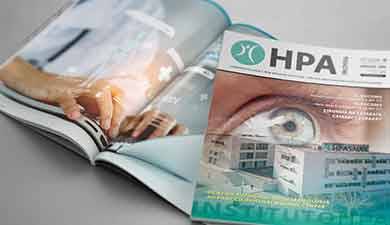Enf.º Luís Fernandes
Director of the Quality Department

Customer satisfaction
An organizational tool for continuous improvement
HPA Magazine 15
Customer Satisfaction has progressively assumed a prominent position in organizations, as it allows them to assess and analyse their customers' perception of the services as well as the quality of care provided.
Through this analysis, health entities are able to adapt their services, corresponding to the needs and expectations demonstrated by their patients. Nevertheless, the benefits of evaluating Customer Satisfaction are numerous, allowing organizations to guarantee the well-being of employees and customers; to identify potential aspects and services and to improve and avoid unnecessary expenses.

As far as the patient’s well-being is concerned, a satisfaction assessment and the application of the continuous improvement process will result in obtaining the patient’s loyalty, connecting him to the organization. It is, therefore, an extremely important tool, which essentially allows the company to receive information and is also a means of communication with the patient.
As a general rule, quality is defined as meeting consumer expectations. In the health sector, the definition of customer and quality criteria are more complex elements than their counterparts in other areas of the market. Of course, the consumer is the patient who receives medical treatment, but what he receives is not something he fully understands. In addition, the hospital's quality concept differs between the three agents involved: a) the patient himself, b) the hospital's health professionals and c) the provider agents, such as insurers and subsystems.
Patient satisfaction can be understood as patients’ perception of what they need combined with meeting their expectations, as well as the evaluation of their condition and the results of their experience with the treatment. Satisfied patients have better acceptance of the treatment, provide more reliable information to the professionals who assist them and tend to continue to use health services, even becoming promoters of the health unit.
To promote customer opinion is an indispensable contribution towards the guarantee of quality services, as well as the smooth running of the organization. The client is included in the process of continuous improvement, as an active and critical part, by being invited to share his opinion and his experience with the service provider.
Currently, the existing assessment tools available to evaluate Customer Satisfaction in a Health context are numerous, with no congruence in relation to which is the most appropriate, as far as the various peer companies are concerned, and many others have been implemented in an empirical way without coherence, with imprecise references, including irrelevant or excluding important issues.
As the Grupo HPA Saúde has received International Clinical Accreditation (by Joint Commission International in the Alvor and Gambelas Hospitals), it was decided to use internationally validated assessment tools widely used in the most prestigious health institutions worldwide and perfectly adaptable in a national and regional context.
Thus, in the HPA Saúde Group, the Net Promoter Score (NPS) is used as a tool for assessing customer satisfaction.
With NPS it’s possible to measure the degree of the consumer loyalty related to each unit through the question: "How likely are you to recommend the Grupo HPA Saúde to a friend or family member?"
Based on a scale of 0 to 10, customer responses are classified / grouped in three ways:
- 0 to 6 // Detractor Patients: Are the patients who have had a bad experience, criticize the Hospital or Clinic in public and will only use our services again if they have no alternative.
- 7 e 8 // Passive Patients: Are patients who have no opinion. They are not loyal and they are not enthusiastic about the company.
- 9 a 10 // Promoter Patients: Are the patients who have had a positive experience and are satisfied. They are loyal, offer positive feedback and are enthusiastic about the services we provide.
According to NPS results, it is possible to arrange each unit into four “Rating Zones”, which in general terms will exemplify how well the company / unit is ranked related to customer satisfaction. The zones are:
- Zone of Excellence: NPS between 76 and 100
- Quality Zone: NPS between 51 and 75
- Improvement Zone: NPS between 1 and 50
- Critical Zone: NPS between - 100 and 0
In units with inpatient services, in addition to the NPS, a more extensive questionnaire is provided based on the HCAHPS (Hospital Consumer Assessment of Healthcare Providers and Systems) which permits the company to obtain the perception and experience of the inpatient in areas such as:
- Communication with the various professionals;
- Readiness to respond to patients' requests/needs;
- Cleanliness and noise level of the hospital;
- Pain management;
- Information on medication and treatment;
- Information and preparation for discharge.
In conclusion, the patient satisfaction is considered an indicator of quality and constitutes an important management tool, given its ability to contribute to the organizations decision-making process, to identify the best ways to serve the patient and also to establish mechanisms that eliminate failures in the patient assistance process.
In order for patient satisfaction to increase effectively, it is extremely important that managers implement a cycle of continuous improvement through the feedback obtained, and also ensure mechanisms for employee involvement.








